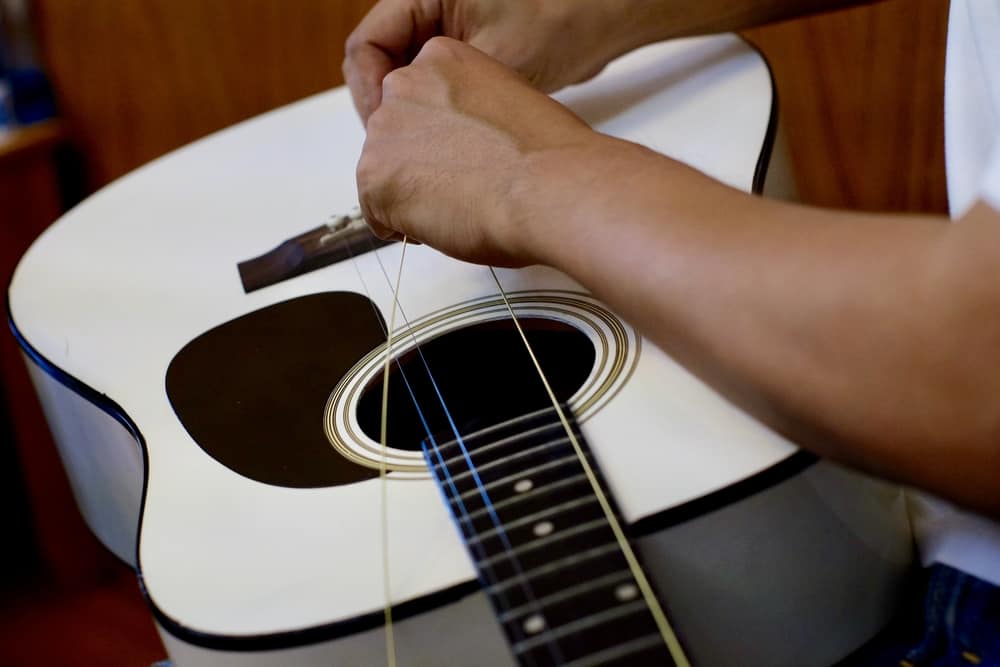
Changing your guitar strings is a simple process that can make a big difference in the sound of your instrument. Many guitarists recommend changing them every few months or at least once a year. Depending on how often you play and what type of strings you use, they may need to be changed more or less frequently. If you’re not sure how often to change your strings, ask your guitar teacher or another experienced musician.
Generally speaking, guitar strings usually cost between $7 and $30, depending on the material from which they are made. When you decide not to restring them by yourself, music stores generally charge an additional $10-25 for the restringing service. Thus the estimated cost of restringing a guitar can range between $7 to $50.
Most beginners use steel-core strings because these are more affordable and easier to play than other types of strings. More advanced players often prefer nylon or silk-core strings, which produce a smoother tone but typically cost more.
This article will explore the process of stringing your guitar and how to determine when you need to replace them. We will also look at some tips for buying new strings and taking good care of your instrument.
When Should I Replace My Guitar Strings?
There are a few signs that it might be time to replace your strings.
The Strings Are Fraying or Breaking
If you notice that the strings are beginning to fray or break, it’s time for a new set. Strings can break for a number of reasons, including wear and tear, bad technique, or using the wrong type of string for your instrument.
They Don’t Sound as Good as They Used To
If your strings start to sound dull, it’s probably time for a change. This is especially true if you’ve played a lot; over time, the strings will naturally lose some of their lusters and sound less vibrant.
When They Buzz or Make Unwanted Noises
If your strings are buzzing against the guitar, it’s good to change them as soon as possible. This could be caused by several factors, including an improperly positioned fret, a poor string choice, or too much friction caused by dirt and debris in the instrument.
What Type of Guitar Strings to Buy?

If you are a beginner, you may be wondering what type of strings to buy for your guitar. There are many different types of guitar strings, each having its advantages. One of the most common types is steel-core strings, which are available in medium or light gauge and can easily be found at most music stores or online.
If you want to try something different, there are other options. Some players prefer nylon or silk-core strings because they produce a smoother tone and last longer than steel-core strings. However, these tend to cost more, so it’s important to consider your budget when deciding whether to purchase them.
No matter which type of string you choose, it is crucial that you take good care of your instrument by cleaning it regularly and keeping it stored in a safe place when not in use. This will help extend the life of your strings and keep your guitar sounding its best.
How to Restring a Guitar

Installing new guitar strings might seem daunting, but it is pretty simple. The first step is to find the right gauge of strings compatible with your guitar. Most players prefer medium-gauge strings, as these offer a good balance between sound quality and playability.
Once you have selected your new strings, carefully remove the old ones from your guitar by unwinding them from the tuning pegs and removing them from the bridge. Then, follow the instructions that come with your new string set to install them on your instrument. Generally speaking, this involves winding each string in reverse order.
Tips for Keeping Your Guitar Strings in Good Condition
If you’re a guitar player, keeping your strings in good condition is one of the most important things you need to take care of. After all, your instrument’s sound quality and playability depend on the quality of your strings.
Below are some tips for keeping your guitar strings in great shape.
Temperature
Avoid exposing them to extreme temperatures or humidity levels. This can cause the metal in the strings to stretch or break more easily, which will affect their tone and performance. If you live in a humid climate, try using a dehumidifier so that your guitar stays in optimal condition.
Cleaning
When changing out your strings, clean off any gunk or dirt that has accumulated on the bridge or saddles. This will help keep your strings from rusting and improve their tone.
Tuning
Be careful when tuning your guitar. If you adjust the strings too tightly, you can damage the metal in the strings and cause them to snap. Always err on the side of caution and tune slowly to avoid putting too much strain on the strings.
Chemicals
Avoid using harsh chemicals or cleaners on your guitar strings. These can damage the metal and shorten the lifespan of your strings. Instead, use a soft cloth to wipe down your strings after each use.
Storing
When storing your guitar, make sure to put it in a case to protect it from dust, dirt, and other harmful elements. This will help keep your strings in good shape and prevent them from wearing down too quickly.
By following these tips, you can keep your guitar strings in excellent condition for a long time. With regular care and maintenance, you can continue to enjoy playing your instrument at its best.
Conclusion
Whether you are a beginner or an experienced player, keeping your guitar strings in good condition is essential for getting the best sound and performance from your instrument. Several tips can help you achieve this goal, including avoiding extreme temperatures and humidity levels, cleaning the bridge and saddles, tuning slowly to avoid damaging the metal, using soft cloths for cleaning rather than harsh chemicals, and storing your guitar in a protective case.
With these simple steps, you can ensure that your strings stay strong and last longer so that you can continue to enjoy playing your favorite songs on your guitar.









